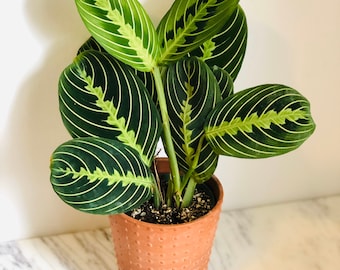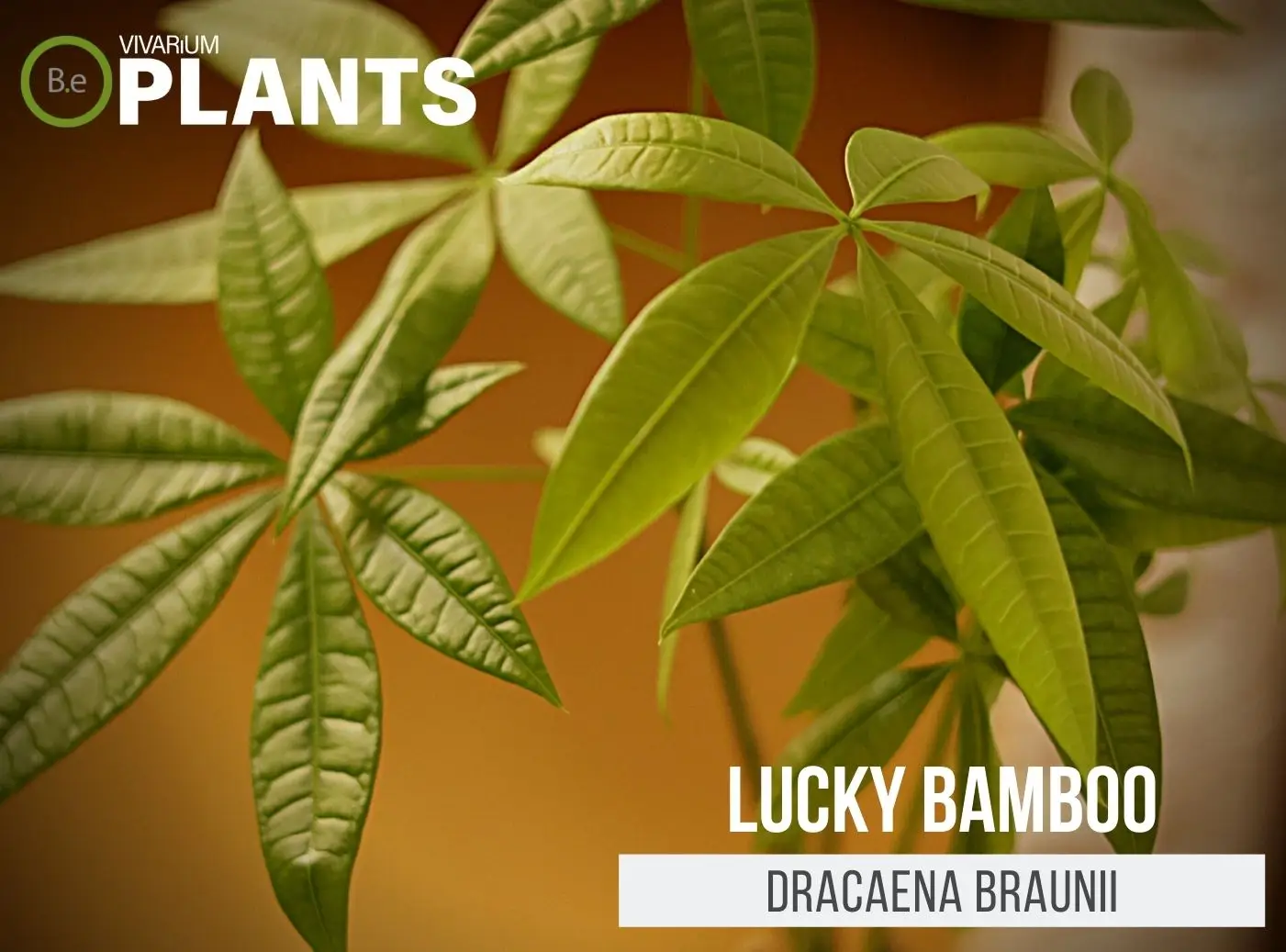Maranta leuconeura, more commonly known as prayer plant, is an evergreen perennial well worth considering for inclusion in a vivarium.
It is a beautiful plant, the leaves of which fold up together at night in a manner that resembles the hands of a praying person and so gave the plant its poetic name.
It is a good choice for an enthusiast who likes to observe tropical plants, as the plant has a dynamic appearance.
Table Of Contents:
ToggleWhat is a Prayer Plant?
The prayer plant is native to tropical rainforests in Central and South America and is fairly tolerant of low lights.
Characterized by its stunning deep greens and rich purple undersides.
This tropical plant is an ideal pick for those who are looking for a splash of vivid colors in their vivarium.
This plant grows to be around six to twelve inches in height and its beautiful foliage gives the enclosure a lush, tropical feel.


Prayer Plant Facts
Uniquely, the leaves of the prayer plant roll upwards at night, usually around dusk, in a manner akin to hands in prayer, its nickname inspiring the process.
Maranta leuconeura is also commonly known as the herringbone plant or pancake plant.
This is because of the stunning pattern of its leaves when seen from above. The plant works well with any terrarium, with or without animals that consume it, and is safe for them.
Description
The Maranta leuconeura is a beautiful plant with a pair of leaves five to nine inches in length and three to six inches wide.
It has a remarkable pattern on the upper surface of the lamina in the shape of a pattern of narrow bands.
The underside is often a deep purple color. The leaves of this plant have a thin, velvety texture and the stems are relatively tall for a comparatively small plant.
Habitat
Originally, the prayer plant is native to tropical South America, more specifically in Southern Brazil, where it is surrounded by moist warmth in its habitat.
In a vivarium, prayer plants will grow in locations with a wide range of temperatures.
In its natural environment, Maranta leuconeura grows in dense forests and will usually grow in areas of high humidity.
PH Preference
Maranta leuconeura prefers a mildly acidic soil pH range of 5.5 to 6.5, so it is important to test your soil so the right pH can be adjusted and the moss will thrive.
This is a great option for vivariums that need a boost in acidic solutions.
Vivarium Type
The prayer plant is quite an easy-going species.
With that in mind, it will not be too complicated when it comes to choosing the type of enclosure it is grown in.
It is best to try and replicate the plant’s natural habitat as much as possible.
Doing so will make it easier to provide this foliage plant with its basic needs.
The proper setup and theme of the enclosure will make a big difference to the overall look and health of the plant.
Be sure to choose setups that are moist and high in humidity. Here are recommended vivariums it will do well in:
- Paludariums – Half aquatic/ half terrain-based enclosure.
- Terrariums – Fully terrain-based enclosures with little to no aquatic features.
Vivarium Placement
The prayer plant can be used successfully in a terrarium as both a foreground and background plant.
It is a rather low-growing plant that can stay as short as 6 inches tall.
When in the presence of a higher degree of light, Maranta leuconeura is capable of growing taller than a foot in height.
When low light is present, the Maranta leuconeura will stay relatively short and compact.
In terms of layout and design, prayer plants look the best when used as edges of the hardscapes, around the top of hardscape walls, and scattered around the vivarium background.
Substrate
When setting up substrate for Maranta leuconeura it is very important to use terrarium soil that is nutrient-rich, as this will provide essential nutrients to the plant.
By using high-quality soil you will ensure that the prayer plant receives the right amount of nutrients, obtaining an optimal growth rate.
Lighting
The prayer plant is a small tropical plant and it prefers medium to high light intensity with limited direct sun exposure to prevent burning the leaves.
LED terrarium lighting would be the best solution, simulating the look of natural sunlight without the risk of burning or wilting the Maranta leuconeura.
Too much lighting can cause this plant to shrink and lose its vibrant green color.
Buy Prayer Plant
When it comes to buying prayer plants, there are a few things to keep in mind.
Making sure the plant is healthy when purchased is essential for its success in a vivarium.
Vegetation that is already in poor conditions will have a very hard time adjusting to new environments.
Click the image below to find out more about the current price and other relative info about this plant.


Prayer Plant Care and Propagation
Maranta leuconeura is very easy to care for and a good choice for both novice and experienced vivarium owners.
The plant is also quite versatile, as it can be propagated from seeds, cuttings, or plugs.
When taking cuttings, choose a node from a mature plant but be gentle, so you won’t damage the base.
It is possible to root the cutting in soil, spores, or water and the roots will become present in as few as two weeks.
How to Grow
The prayer plant will grow best in slightly acidic, rich soil, and it prefers increased humidity and well-drained soil.
To avoid root rot, make sure to plant the prayer plant in a container with a good drainage layer.
Additionally, if the environment is dry a pebble tray can be used in order to increase the surrounding humidity.
Planting the Maranta leuconeura directly in the vivarium should be done with caution, as the soil can quickly compact if too much traffic is present.
Watering
This particular plant prefers regular, moderate watering to thrive.
To avoid root rot and other issues related to too much or too little water the best approach would be to water the prayer plant when the soil is slightly dry.
This can be done by lightly sticking your index finger into the soil to feel the level of moisture.
Overwatering is easy to do with this plant and it can cause root rot and other issues.
Plants Similar to Prayer Plant
Adding diversity to an enclosure is key to an aesthetically pleasing setup.
Try mixing up the look of your vivarium with different flora that can easily co-exist in the same types of environment.
Furthermore, if for some reason you find the prayer plant is hard to acquire or would like to consider something similar to this plant…
Here are other foliage plants you might find will do well with or in the place of Maranta leuconeura:
Conclusion
Maranta leuconeura, otherwise known as the prayer plant, is a truly beautiful species well worth consideration in a vivarium.
It is also easy to care for and to propagate, adding to the list of its desirable qualities.
This plant loves medium to strong indirect sunlight and well-drained loamy soil, meaning it is the perfect plant for a range of vivariums.
Overall the tropical plant’s bright colors and eye-catching leaves will give your vivarium a real splash of vibrancy and life.
Frequently Asked Questions
The Prayer Plant (Maranta leuconeura) is a low–maintenance, easy–to–care–for houseplant with beautiful, decorative foliage that starts to fold up in the evenings, resembling praying hands – hence its name! Its leaves are usually dark green with bright green feathered veins, and often feature showy silver or red spots. The Prayer Plant is also known to be a good air purifier, helping to remove toxins from the air in your home.
No, prayer plants are not difficult to take care of. They require bright, indirect light and evenly moist soil To keep your prayer plant looking its best, mist the leaves regularly and provide high humidity. With proper care and attention, prayer plants can make a beautiful addition to any home or vivarium.
Yes, Prayer Plants make excellent houseplants! Prayer Plants have attractive foliage and are especially known for the way their leaves fold up at night, giving them the nickname of “hands up“ plants. They thrive in partial shade to full shade and high humidity, so they are perfect for indoor environments. The soil should be kept slightly moist but not too wet, and temperatures should range from 55–85 degrees F.





